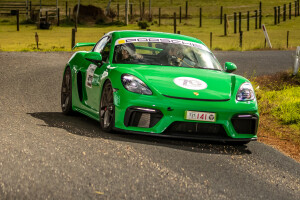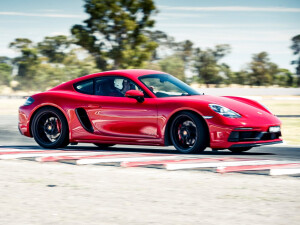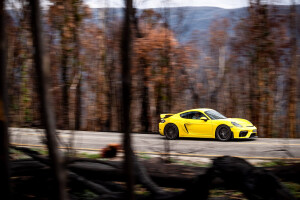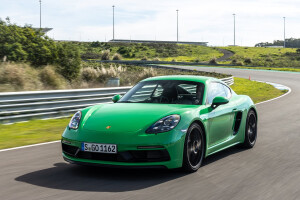Latest Review
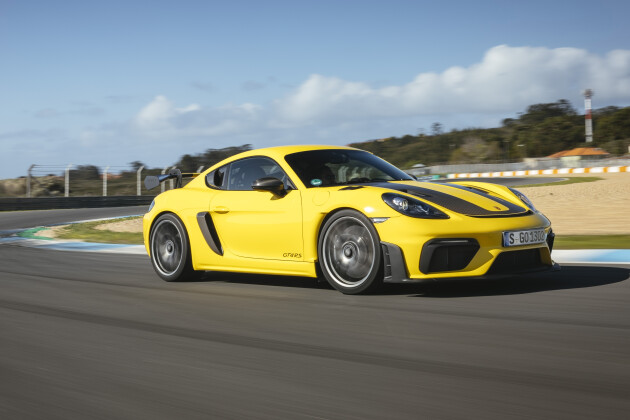
2022 Porsche 718 Cayman GT4 RS review: First international drive
The heart of the Porsche 911 GT3 and mid-engine Cayman platform finally get the marriage we’ve always wanted
Enthusiasts love to describe the more track-oriented vehicles like the 2022 Porsche 718 Cayman GT4 RS as ‘race cars for the road’. The reality is, even for the most hardcore track day toys, that is rarely anywhere near the truth. That’s because race cars are savage, and even in their milder forms patently unlike anything you can drive off a showroom floor wearing a number plate.
Case in point is this Cayman GT4 RS, a new flagship for the 718 platform, with the screaming 4.0-litre atmo flat-six of the current 911 GT3 shoehorned between the cabin and rear axle, lighter bodywork, more aggressive aero and gumball tyres.
Being an RS, the new Cayman halo is unashamedly track-focused in its design, character, and purpose. And while there will be people that proclaim it to be, the Cayman GT4 RS is not a race car for the road. It is a road car that has been tuned, tweaked, reworked and finessed into the ultimate expression of sportscar capability, in turn, giving it astonishing abilities on a circuit, in this instance the iconic Autodromo do Estoril grand prix circuit in Portugal.
It’s no spoiler to say the Cayman GT4 RS is mightily impressive on track, but where it gets closest to transcending that ethereal barrier between race and road is cabin noise. Anyone lucky enough to have sat in a motorsport-prepared cabin will know the sound inside the cabin borders on deafening. Few cars with licence plates have ever come close to replicating that experience. Cue the GT4 RS.
Instead of windows behind the B-pillar, the GT4 RS features carbonfibre air intakes, with both sides feeding directly into a central air box placed behind the occupants inside the cabin. Let us repeat that. The airbox is in the cabin. And that aural assault massively impacts the driving experience.
Why has Porsche built the loudest cabin we’ve ever experienced this side of a literal race car? Speaking to one GT4 RS engineer, it was explained that the team realised the exhaust had to be muted so it could meet decibel restrictions for various markets, but there were no such regulations mandating a maximum noise limit inside the car’s cabin. The results are as dramatic as they are varied.
Instead of windows behind the B-pillar, the GT4 RS features air intakes feeding directly into a central air box inside the cabin. Let us repeat that. The airbox is in the cabin
At road speeds, there is a wide range of tenors and frequencies that fill your ears in the cabin. Engine load and speed has a dramatic impact on the varying noises, with your right foot playing the conductor for a six-cylinder orchestra that can play a tune of a wistful whisper, all the way to a 9000rpm raucous crescendo.
On track, you need to literally shout to be heard. From the outside, both the standard stainless steel and optional titanium exhausts stir the soul with A-grade flat-six tones. Perhaps making this achievement so impressive is the fact that not one, but two petrol particulate filters are fitted to the car.
This auditory celebration is all thanks to the 4.0-litre naturally aspirated flat-six engine that comes straight from the Porsche 911 GT3.
While the car community has been baying for the Cayman platform and GT3 engine to be combined as one for quite some time, Porsche executives had previously steadfastly refused the proposition in order to protect the turf of the track-ready 911.
Thankfully, that edict has been banished and the 718 platform has been given an opportunity to get the RS badge it has long deserved.
Porsche has listened to our criticisms of the GT4 and fitted the shortest possible gear ratios to the RS’s seven-speed PDK dual-clutch (as is modern RS tradition, there is no three-pedal variant). Where the GT4’s second gear topped out at 128km/h, the RS will be shifting to third at 116km/h and the gap only increases from there as you climb through the ratios.
Peak power of 368kW arrives at 8400rpm (of the possible 9000 revs available), while maximum torque of 450Nm comes on tap at 6750rpm.
Don’t get the slight drop in power compared to the GT3 misconstrued as any sort of sly nerfing by Porsche, instead look to the change in exhaust design and header length. Those figures are enough to propel the GT4 RS to 100km/h from a standstill in 3.4 seconds, 200km/h in 10.9 seconds, and onwards to a claimed top speed of 315km/h.
It feels quicker. Combining the much closer-stacked gear ratios with an extra 1000rpm gives the RS the frenetic shove that was disappointingly absent from the ‘standard’ GT4.
Australians looking to order the most powerful and capable Cayman ever built will need to set aside $300,800 for the privilege, before on-road costs, with local deliveries expected in Q3 of this year. On top of that asking price are two important options packages. The first is the Clubsport Pack, which adds the half-cage behind the rear seats, a six-point racing harness for the driver, a fire extinguisher, and battery disconnect switch.
The Weissach Pack adds on top of that a set of forged magnesium wheels that, while not as handsome a design as the standard rims, provide a considerable unsprung weight saving, plus a titanium sports exhaust system and lashings of carbonfibre inside and out.
Australia’s entire allocation of GT4 RS isn’t completely sold out … yet. The first batch is already spoken for, but Porsche has said it’ll build as many of the hardcore variant as possible in its non-limited production run, which is set to continue until 2024.
Everywhere you look, Porsche engineers have made the slightest of tweaks to improve the Cayman breed to the best it has ever been
Improvements for the Cayman’s RS debut extend well beyond a new powertrain. The entire body has been lowered by 30mm, while the front track is 6mm wider, and rear track is 8mm wider than the standard GT4.
The RS also has 25 per cent more downforce than the GT4 with its aerodynamic devices in their most aggressive setting, thanks in part to a new swan-neck rear wing and slats in the front wheel arches that help reduce high-speed front end lift.
Everywhere you look, Porsche engineers have made the slightest of tweaks to improve the Cayman breed to the best it has ever been. One example of this attention to detail is the quarter of a degree increase in rear camber.
There wasn’t much in the way of fat on the bone with the GT4, but Porsche has trimmed 35kg for the RS Cayman. Part of that is thanks to carbonfibre reinforced plastic (CFRP). The bonnet, as well as front and rear spoilers, are constructed from CFRP, while the rear window is fitted with lightweight glass. The Cayman’s usual compartment privacy panel? Gone altogether. Because Race Car. Fitting the optional forged magnesium wheels at all four corners shaves a further 10kg in mass.
As fastidious as Porsche’s diet for the GT4 RS was, there was one area in particular they decided a weight increase was necessary – the brakes.
Growing in size from the GT4’s 380mm diameter front discs, the RS Cayman is equipped with 408mm monsters as standard, with 410mm carbon-ceramics available as an option. These larger front brakes also receive additional cooling, channelled from the pair of NACA ducts located on the bonnet. Rear discs are lifted from the current 992-gen GT3, measuring 380mm in diameter (390mm for the optional carbon-ceramic units). Aluminium monobloc callipers are fitted front and rear; six-piston fore, four-piston aft.
After a day of track driving, the carbon brakes were still stopping the GT4 RS’s 1415kg (plus driver) mass on corner entry with impressive force. It was initially daunting how deep into the braking zone our lead driver was staying at maximum throttle on Estoril’s front straight before standing on the picks.
But every time, we managed to make the first turn comfortably. Stability under heavy braking was rock solid, with the pedal communicating how the tyres were clawing at the tarmac right to the edge of ABS intervention.
A front nose lift is available for the first time in the Cayman’s history, the system capable of hydraulically raising the front suspension by 30mm, resulting in a 40mm lift at the tip of the front lip. You need this option if you intend to use the GT4 RS in Australia. The system operates up to 60km/h, and we needed to use it a number of times on the road drive route to avoid scraping the Cayman’s nose against some of Portugal’s historic cobbled streets.
The front axle for this most potent of Caymans is actually taken from the 991.2 GT3 RS, including the MacPherson strut suspension design.
Engineers have improved a design that is beginning to show its shortcomings by fitting a clever twin spring system that works by having helper springs fitted that assist in keeping the suspension’s main springs under tension when deflected, in turn allowing the larger of the two springs to maintain its original tension levels under maximum load to improve car control during hard driving.
Despite the inherent compromises of a MacPherson strut design, the GT4 RS, much like all Caymans, has fantastic steering calibration. The weighting is beautiful and builds up naturally with corresponding corner loads. A steady stream of feedback flows through the wheel to the driver, keeping you informed of the grip levels at any given moment.
It’s only when you drive the 992 GT3 do the slightest of shortcomings of the GT4 RS’s steering come to bear as it fails to match that final one per cent of accuracy in the way road texture is transmitted compared to a double-wishbone set-up. The difference is akin to steering with 8K Ultra-HD resolution compared to the Cayman's 4K. Both are great, but one is better.
The Porsche Stability Management (PSM) system is sympathetic of small slides, but does bleed power if you indulge in power oversteer for too long. That’s easily induced out of Estoril’s tight, off-camber, uphill Gancho chicane that feeds into a sweeping right-hander. PSM interventions are sly, instead of a vicious rug pull.
Play with the throttle and you can feel as the Cayman dextrously shifts its balance from over- to under- back to oversteer
The steep chicane near the end of the lap feels abrupt in the flow of the Portuguese circuit, having been installed after the death of Ayrton Senna and has remained largely unchanged since. It’s through the final corner, the Parabolica Ayrton Senna, that the GT4 RS’s talents are simultaneously tested the hardest and shine the brightest.
Play with the throttle through the 180-degree sweeper and you can feel as the Cayman dextrously shifts its balance from over- to under- back to oversteer. This neutral chassis balance acts as a canvas for a driver to paint with their preferred driving style.
Aiding early corner rotation is torque vectoring by braking on the rear axle, which Porsche dubs PTV. This system cannot be turned off – unlike the stability control and traction control – and works by braking the inside rear wheel ever so slightly as soon as the steering wheel is rotated. A mechanical limited-slip differential with RS-specific locking values (30 per cent traction, 37 per cent overrun) is fitted as standard and deploys the flat-six’s power without flaw.
The narrow focus of the GT4 RS means it isn’t as comfortable on the road as it is on track. You need to be willing to sacrifice refinement for performance. The suspension’s tracking, camber, and anti-roll bars are all manually adjustable front and rear for the driver that really wants to get nerdy with it, while adaptive dampers are standard.
In the ‘softest’ setting, and we use that term advisedly, the GT4 RS is hard-up against what would be considered bearable on the road, and will also firm up without driver input when the system detects dynamic driving.
To improve on-road compliance, the engineers opted for what initially seems to be a counterintuitive philosophy of slackening off the anti-roll bars while stiffening the springs as much as is tolerable. Paired with a stiffened chassis, the GT4 RS has incredibly taut body control, but the softer anti-roll reduces the effects of bumps on individual corners of the car.
A trade-off is that full-width road seams or bumps impacting both sides of the GT4 RS simultaneously are felt keenly via the ultra-stiff spring rates. The adaptive damping does an impressive job of preventing these occasions from being crashy or unsettling, but it’s the biggest and higher frequency hits that knock the GT4 RS’s composure after it so deftly shirks smaller mid-corner imperfections.
The bigger question is whether the GT4 RS steps too far into the territory held so dominantly by the 911 GT3 … The answer sits steeped in nuance
Compared to the GT3, the Cayman GT4 RS utilises a slightly smaller Michelin Pilot Sport Cup 2 R rubber footprint (245/35/ZR20 at the front, 295/30/ZR20 on the rear), which in conjunction with the shift in engine position gives the pair distinct driving characters.
As a result, the GT4 RS is more willing to move around mid-corner, being a more playful, lively, and challenging car to hustle at maximum attack.
The bigger question perhaps is whether the GT4 RS steps too far into the territory held so dominantly by the 911 GT3 – a slice of the market that Porsche executives fought tooth and nail to protect from even internal challengers. And the answer sits steeped in nuance.
View the issue from distance and yes, the GT4 RS and GT3 do much the same thing in being ferociously capable track cars from a Porsche GT department that seems determined to give the purely internal combustion-powered sportscar an all-time farewell party.
But focus on the details, all those tiny engineering changes, and the GT4 RS’s intense track focus diverges from the vehicle with which it shares that lion-sized heart.
A playful wink from the Cayman GT4 RS’s architect – GT division boss Andreas Preuninger – when discussing how high the bar can be elevated from here indicates that this is not the zenith for the current era of Porsche performance cars; the 911 GT3 RS is, after all, waiting in the wings. A rising tide lifts all boats, and the GT4 RS is Porsche’s acoustic king tide for the 718’s internal combustion lineage.
Electrification is coming for the Cayman and its Boxster sibling, but before the inevitable arrives, we get to enjoy a recipe so good that it was denied us for decades.
2022 Porsche 718 Cayman GT4 RS specifications
Things we like
- Epic noise
- Shorter gear ratios
- Lively character
Not so much
- Compromised on-road manners
- We had to wait so long for it to arrive
News
-
 News
NewsPorsche's electric racers are EV road car testbeds
Carey whips the GT4 ePerformance around the track in Franciacorta, Italy
-
 News
NewsPorsche 718 Style Edition Boxster and Cayman released in 964 Carrera RS colour
Based on the standard 718 Cayman and Boxster, the Style Edition harks back to the 964 Carrera RS with its Star Ruby Neo paint
-
 News
NewsPorsche’s future: Macan EV 'delayed', 3-row SUV coming
A new report suggests software-related issues have delayed the launch of the new electric Macan, as development work on a three-row SUV commences
-
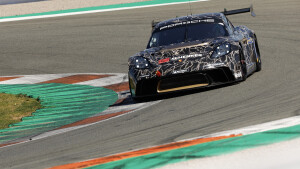 News
NewsPorsche 718 Cayman GT4 ePerformance showcases Mission R technology
The Mission R's powertrain is good enough to make a Cayman as quick as a 911 GT3 Cup
-

2023 Porsche 911 Carrera RS and 718 Spyder RS rumoured
-
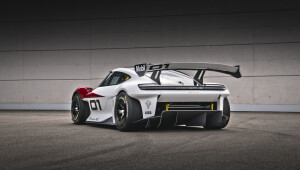
Porsche 718 Boxster and Cayman to go electric by 2025
-

Storm Chasing: 2022 Porsche Cayman GT4 takes on some of Queensland’s best roads
-
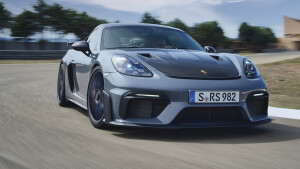
How Porsche is tackling the challenge of building electric sports cars



